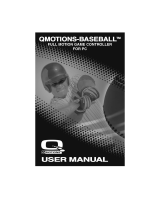QMotion Qrelay is a range extending repeater for QMotion Roller Shades. It is designed to extend the range of a remote, Qsync, or Qconnect. Any transmitter has a limit on how far it will reliably control a shade. The Qrelay allows this distance to increase so that better results may be achieved.
Here are some possible use cases for the Qrelay:
- Controlling groups of shades separated by a long distance from a Qconnect or Multi-Channel Remote.
- Helping to control shades that are in an RF dead zone.
- Overcoming difficult shade placement.
The Qrelay is easy to use. Simply plug it into any powered USB jack and it will automatically enter the Echo All mode. This means that it will echo any command it receives from a QMotion Roller Shade remote.
QMotion Qrelay is a range extending repeater for QMotion Roller Shades. It is designed to extend the range of a remote, Qsync, or Qconnect. Any transmitter has a limit on how far it will reliably control a shade. The Qrelay allows this distance to increase so that better results may be achieved.
Here are some possible use cases for the Qrelay:
- Controlling groups of shades separated by a long distance from a Qconnect or Multi-Channel Remote.
- Helping to control shades that are in an RF dead zone.
- Overcoming difficult shade placement.
The Qrelay is easy to use. Simply plug it into any powered USB jack and it will automatically enter the Echo All mode. This means that it will echo any command it receives from a QMotion Roller Shade remote.




-
 1
1
-
 2
2
-
 3
3
-
 4
4
QMotion Qrelay is a range extending repeater for QMotion Roller Shades. It is designed to extend the range of a remote, Qsync, or Qconnect. Any transmitter has a limit on how far it will reliably control a shade. The Qrelay allows this distance to increase so that better results may be achieved.
Here are some possible use cases for the Qrelay:
- Controlling groups of shades separated by a long distance from a Qconnect or Multi-Channel Remote.
- Helping to control shades that are in an RF dead zone.
- Overcoming difficult shade placement.
The Qrelay is easy to use. Simply plug it into any powered USB jack and it will automatically enter the Echo All mode. This means that it will echo any command it receives from a QMotion Roller Shade remote.
Ask a question and I''ll find the answer in the document
Finding information in a document is now easier with AI
Related papers
Other documents
-
Legrand GEN3 Installation guide
-
Legrand GEN3 Installation guide
-
Legrand Gen3 Low Voltage8 - Shade Power Box Installation guide
-
Legrand Qsync Installation guide
-
Paxton Vandal Resistant Compact Metal Keypad User guide
-
Legrand QIS Wall Switch (1st Gen Power Panel) Installation guide
-
Legrand QIS Wall Switch (New Power Panel) Installation guide
-
 QMotions Baseball game User manual
QMotions Baseball game User manual
-
Legrand QMOLEEDZRX Installation guide
-
Crestron HZ-KPEX Quick Start





